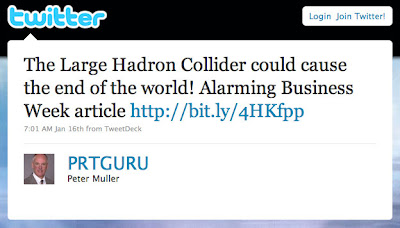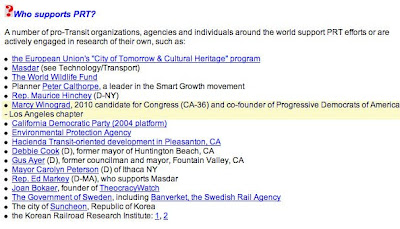Not saying this is or isn't a good use of federal stimulus money. But note that the private sector businessman pitching this is the guy that's been running those full page, star spangled ads about how the country is bankrupt and headed to hell in a handbasket.
The comment is referring to this long-winded opinion piece:
Rekindling the American Dream (11/29/2009)
by Hugh Miller
President and CEO, RTP Co.
Our country is in very serious financial trouble, mortal financial danger, and unless and until we turn it around, quickly, the American Dream will die. But upon reflection it's even worse than that, for while the death of the American Dream would be tragic enough, the end of America being a safe, stable and good place to live would be cataclysmic.
It''s that serious, and as an impassioned American citizen, very worried about his country, there is an obligation to speak out, as forcefully as possible. Here's how I see it.
The national debt we are accumulating is both debilitating and unsustainable, and by most standards we are already bankrupt. What this means, in practical terms, is shortly we will not be able to control our own destiny --others will control it for us. It also means our children, and their children, will not have the same opportunities we had, and in fact will be lucky to find a real job. Further, it means our standard of living declines, rapidly, bringing about extreme and likely violent social unrest. Let me try and explain.
The numbers are staggering and confusing, so I will try and state it in terms we can better understand.
Imagine you, Mr. or Mrs. Public, have take-home pay of $27,000 per year. During the year, however, you spend $47,000, $20,000 more than you take home. How can this happen? You charge things you cannot afford and your creditors look the other way. Anyway, you now have a debt of $20,000 you‚will have to pay back over time. You have a real problem, solvable, but unless you get at it, soon, you'll end up in serious trouble.
Now let‚s imagine you suddenly realize you have a second debt of $120,000. That‚ on top of the $20,000, so the total you now owe is $140,000. That''s a very big number, more than five times your take-home pay. With a really dedicated approach, and cooperative creditors, your debt is still manageable, but only with extreme discipline and understanding bankers.
Believe it or not it gets worse. Now let‚s imagine you‚ have just discovered you have a third debt and will owe another $480,000 in just a few years. That's on top of the $20,000 and the $120,000 for a total of $620,000. That''s more than 22 times your take-home pay, so even if you paid all your take-home pay for 22 straight years you‚'d still be in debt.
You are beyond out of control; you''re a fiscal catastrophe.
Fortunately most of us don't live this way, as we live within our means. Unfortunately, however, our favorite uncle does not. No, our Uncle Sam has spent too much in the past, is spending too much now, and will spend too much in the future.
Mr. or Mrs. Public in this example is actually the U.S. government, not with take-home pay and spending in the thousands, which we can all understand, but with take-home pay and spending in the trillions, which most of us cannot understand.
Instead of taking home $27,000, the U.S. government takes home $2.7 trillion dollars. Instead of accumulating debt of $20,000 over the next year, the U.S. government will accumulate debt of $2 trillion dollars over the same period. Instead of having a second actual debt of $120,000, the U.S. government today has an actual debt of $12 trillion dollars. And instead of discovering you have a third debt of $480,000, the U.S. government has unfunded liabilities, due shortly, of $48 trillion dollars and growing. This would include future payments for Social Security, Medicare, pensions, and other obligations.
How can any person live like Mr. or Mrs. Public? The answer is they can't. How can any government live the same way? The answer is they can‚'t either. Most Mr. or Mrs. Publics know better and would never put themselves in such a terrible position. Sadly, and certainly shortsightedly, and arguably stupidly, the U.S. government has put our country, and all Americans, in extreme financial peril. Worse, they don't seem to care.
If we are to solve our problems, we must first understand them, and so we need to step back and realize just how much we have already borrowed from our future and future generations.
We are a nation of about 300 million people, and we now have a total debt and unfunded liabilities of about $62 trillion. That''s $200,000 a piece! That's truly a startling figure, but that's reality, and that's the burden we've already placed on ourselves. Irresponsible doesn't begin to describe this travesty.
What should we do? Here is what I would do.
1) First we must immediately come to grips with and try to comprehend the dire financial position we're in, today. And we must explain that ugly truth to our people, also today.
2) Second, we must stop things from getting any worse. We simply must start living within our means, within our take-home pay, whether it's $27,000 or $2.7 trillion dollars. In that regard I‚'d be in favor of an amendment requiring our government balance its budget, every year, except in times of war. Until that happens, I'd balance the budget anyway.
3) We don't take in too little, we spend too much -- much too much. Since 1999 to the present the U.S. government has taken in, on average, 4% more per year. Unfortunately, during that same timeframe, they have spent, on average, 9.2% more each year.
Simply put we must cut spending, drastically, tough and unpopular as that may be. The alternative is worse, much worse. Taxing businesses or other job creators is not the answer and will make the deficit worse while increasing unemployment.
Sacrifice will be required by all of us, and it must be done fairly, and that‚''s as it should be. But whatever policies emerge must not be done at the expense of growth, for that would be counterproductive. After World War II we also had a huge debt, but strong economic growth made it much easier to handle that debt. And the reverse is true, the lower the growth the harder it is to pay back debt.
4) Any new spending programs should be shelved until we have a real plan for fiscal solvency. It’s like redecorating your living room while a fire is blazing in your basement. Put the fire out first, completely, before you even begin to think about redecorating.
Our first order of business, by far, is to put out the fire in our basement. Unless and until we fully extinguish that fire we won't have a house to live in anyway.
5) Both the second debts, $120,000 for Mr. and Mrs. Public and $12 trillion dollars for the U.S., and the third debts, $480,000 for Mr. and Mrs. Public and $48 trillion dollars for the U.S., must be dealt with, now. Aggressive repayment and other appropriate procedures, in a bipartisan way, must be implemented immediately. We either solve these problems, together, or we die, financially at least, together. We have no choice, it must be done.
6) Lastly, but certainly not least, we must start rekindling the American spirit, which once was so great, and inspired our ancestors to come here in the first place.
That same spirit turned this country into a great world power, largely by way of American manufacturing, American education, and American entrepreneurialism.
Today that would seem far less likely, as that American spirit is missing. We live in a highly competitive global society, and, sadly, America not only has a fiscal nightmare it has also lost its competitive edge in manufacturing, in K-12 education, particularly math and science, and in entrepreneurialism.
While our first order of business is digging ourselves out of our self-inflicted financial hole, simultaneously we must also start solving our manufacturing, educational, and entrepreneurial problems. By doing that we make ourselves globally competitive and give ourselves a chance to win.
By not doing so we lose.
Those six things are keys to solving our problems and laying the foundation for a successful future. It will be difficult and painful, but it can be done and it must be done.
I often think of my grandfather, who like many others came here with little more than the shirt on his back. But those brave souls also brought with them a dream, a dream of making a better life for themselves in their new country, America --the American Dream. And they did. I've little doubt my grandfather never heard of, let alone understood, the term entrepreneur. But nevertheless he was one, and mainly by hard work and sheer determination established a business, made life better for his family and his community, and created opportunities for others along the way. He lived the American Dream.
Would he be able to do so today? He certainly was strong and determined and his wife even more so, but I‚'m not so sure, in fact I doubt it --there simply are too many roadblocks. Would he even want to come here today? I'm not so sure of that either, and that, to me at least, is really sad.'
Minus that entrepreneurial spirit our economy won't grow, jobs won’t be created, and we'll start to experience an increasingly rapid decline in our standard of living. If we are to recover, it's entrepreneurs who will lead that recovery. Accordingly they must be encouraged, not discouraged.
This looming catastrophe hasn't happened overnight, but clearly it has accelerated rapidly this past year. We‚Äôve trusted our politicians to do the right things, and clearly they‚Äôve betrayed that trust. You might give them the benefit of the doubt by saying they don''t understand the problems, but if that‚'s the case they should find another line of work.
Rather than playing the blame game, however, and God knows there's plenty of blame to spread around going back many years, let’s take the positive approach and just start solving the problems.
Quite frankly we have a mess, actually messes, almost beyond description, and they become increasingly unsolvable the longer we wait. We must start attacking them today. But it's going to take a unified, bipartisan approach, starting right now.
From a personal perspective I would greatly prefer not to be the one highlighting these extremely unpleasant issues. However as an American citizen, very worried about his country, and very worried about the future of his children, and someday their children, and all other people it's children, there is no choice --it must be done. There is, in fact, an obligation.
We can rekindle the American Dream, and we must, but we must get going. Our grandfathers and fathers would want it that way. Our children and grandchildren will be forever thankful.
All that talk about fiscal responsibility and Mr. Miller wants to waste millions of taxpayers' $$$ on a pod pork project.
A screenshot with a quote from Mr. Miller from a brochure (PDF) promoting PRT in Winona.... BTW, who paid for that brochure?
















